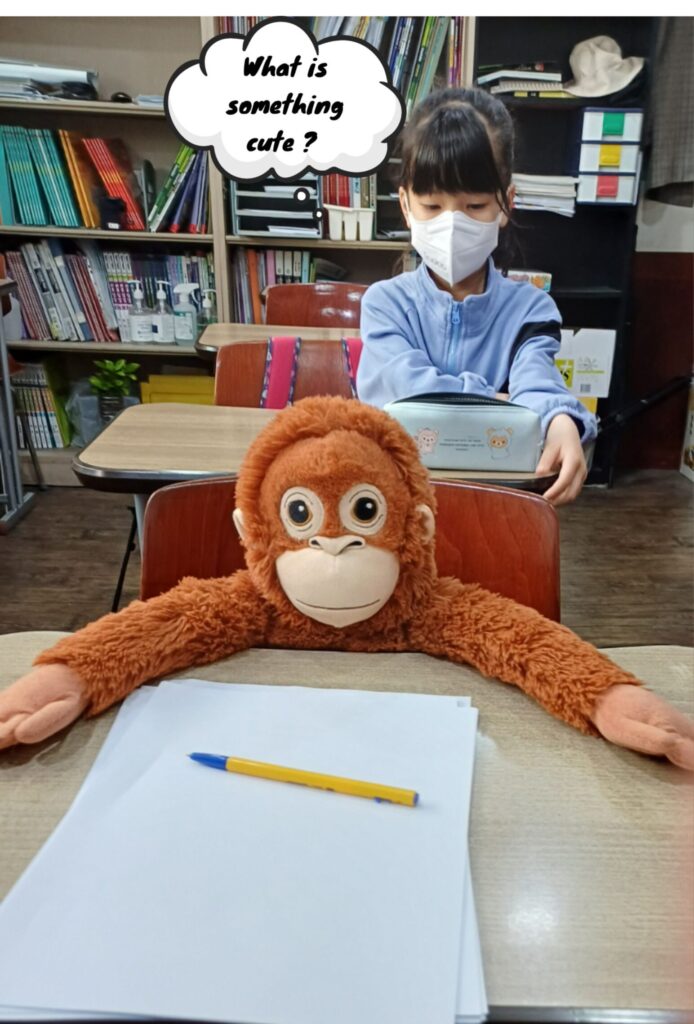
“Ooh! Ooh!“
There are two ways to teach English adjectives in the classroom: boring and fun. The boring way is where the students rote-learn long lists of adjectives, usually with the help of a picture linking it to a noun….Zzz🥱. So, the fun way of using a mix of exercises and games is the way to go. Variety is the spice of a good ESL class, so here are TEN exercises that can help your students learn and practice English adjectives…
Note: Adjectives in English principally occur in two ‘positions’. Adjectives in front of a noun are described as being in the attributive position, and adjectives after the noun are described as being in the predicative position. For example:
I have a cute monkey (attributive position)
My monkey is cute (predicative position)
When teaching adjectives, I first teach the attributive position and embed it into the students’ language structure through practice. Then I teach the predicative position in further lessons.
The exercises are listed first, with those suitable for younger/beginner students, leading to more challenging exercises ideal for older/more advanced learners.
1. Finding Adjectives in the Classroom
Practicing adjectives using tangible objects (realia) is a good idea, and what better way to start than with objects in the classroom?
– The teacher begins the exercise by modeling a question and a target answer on the board:

-Next, the teacher looks around the classroom, chooses an object, and secretly writes it down on a note. The teacher instructs the students to look around and asks the question:
‘In this classroom, can you tell me something old ?’
-The students look around the classroom searching for and calling out ‘old’ objects. Here are a few examples of answers my students gave me:
‘an old desk’, ‘an old book’, ‘an old eraser’, ‘an old teacher‘😥
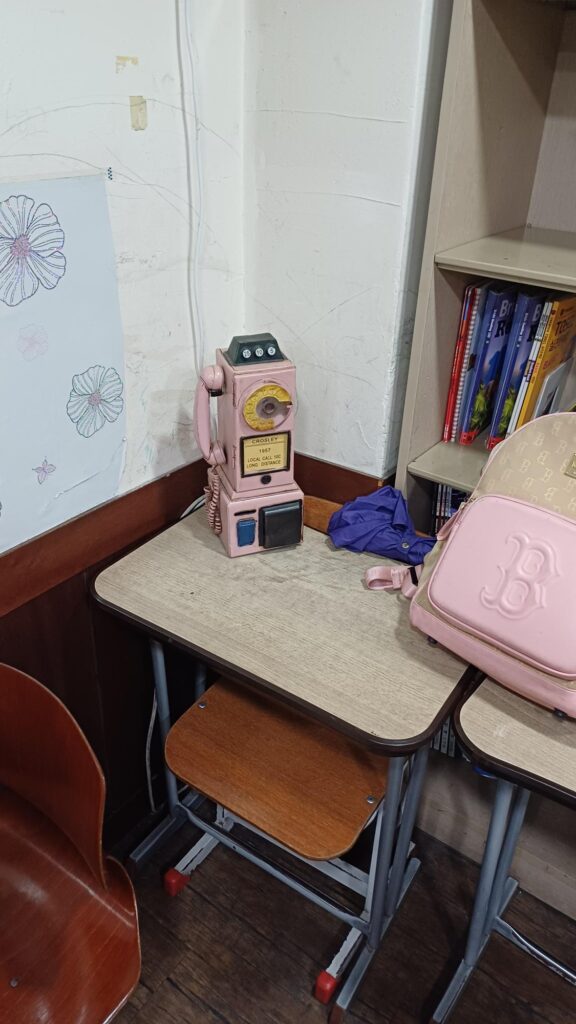
-Eventually, a student will correctly guess the object the teacher chose.
‘an old phone‘
-The teacher shows their note to the class, and the student gets a point.
-Once the students become familiar with the exercise, the teacher steps back and lets them take over running it themselves.
2. Mime the Adjective
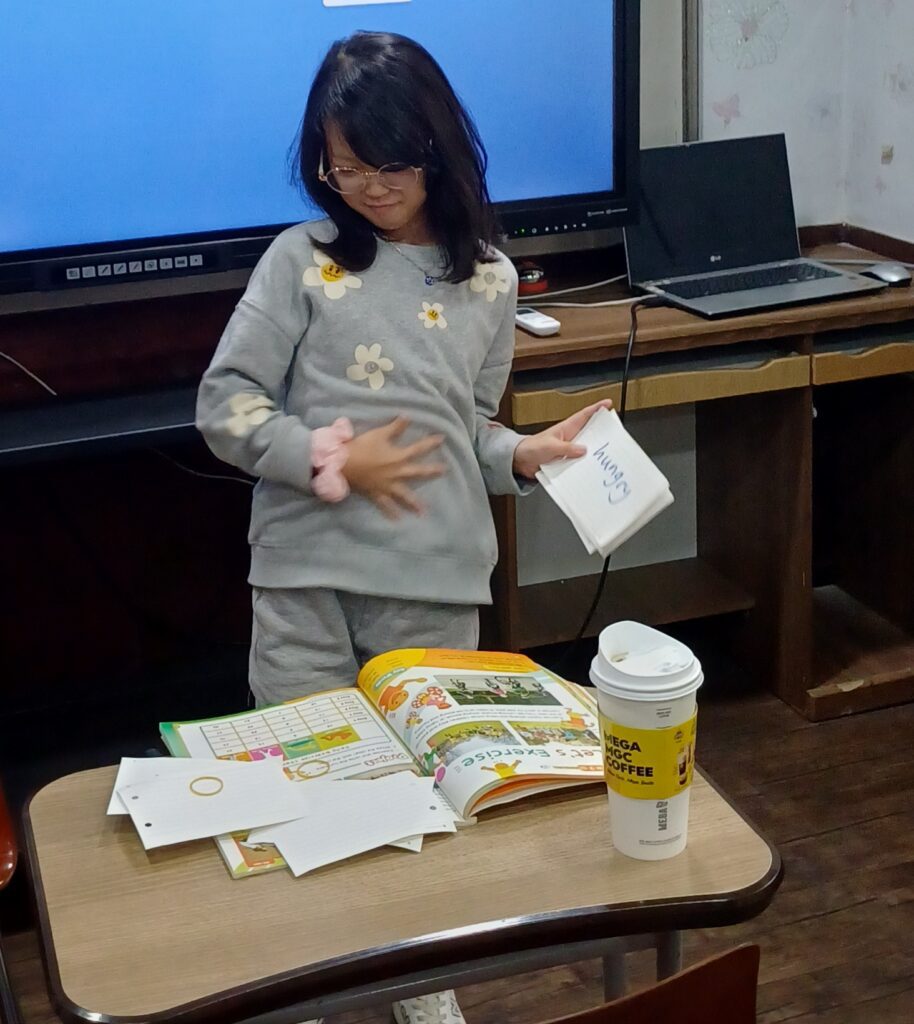


This simple exercise is fun for younger students, and you will get plenty of requests to repeat it.
-To start, one student comes to the front of the class.
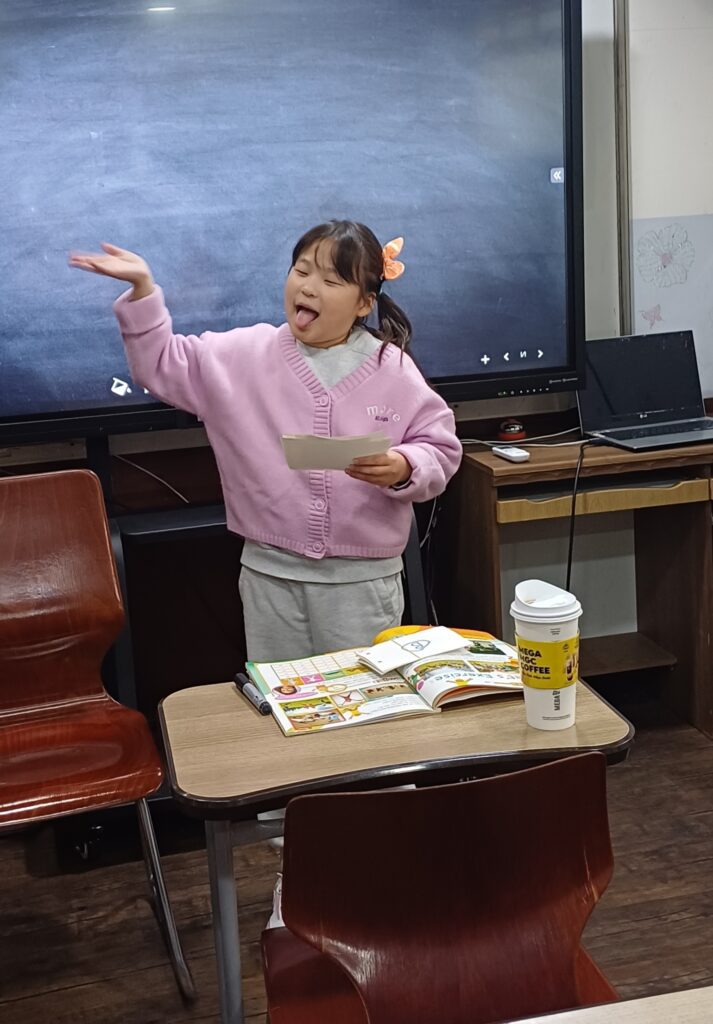
-The teacher shows the student an adjective written on a card.
-The teacher checks the student’s understanding of the word.
-The student has to mime out the adjective to the class.
-The first student to guess the mime correctly gets the next turn to do a mime.
(I think she’s thirsty)

-The exercise can usefully be turned into a team game. One student is nominated to mime.
-The teacher hands them a list of adjectives, and the team has to guess as many mimes as possible within a set time (I usually list a few easy ones at the beginning to get some points on the board and some slightly more challenging ones at the end).
(Using my coffee…now that’s just cheating!)
3. Sketching Adjectives
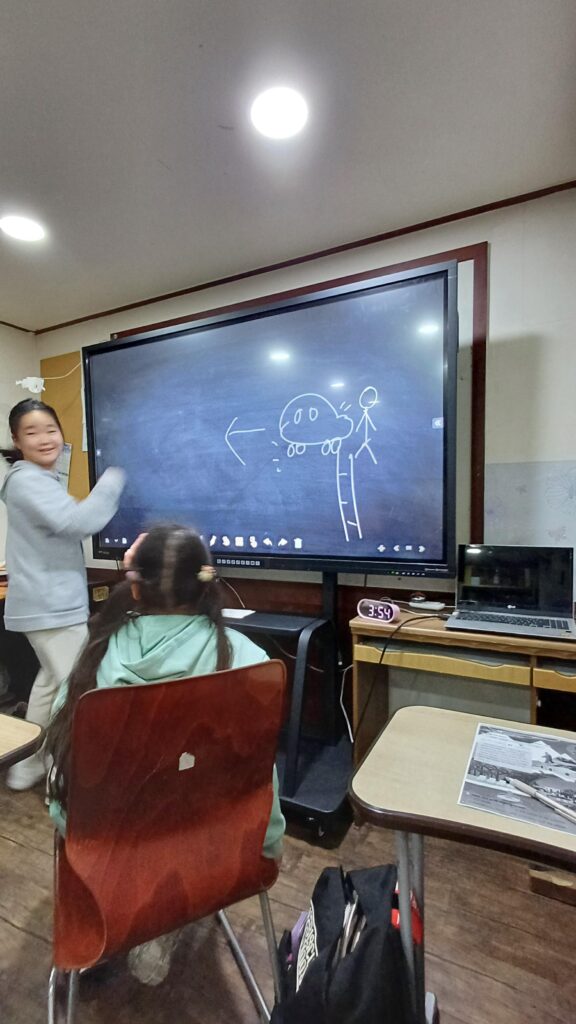
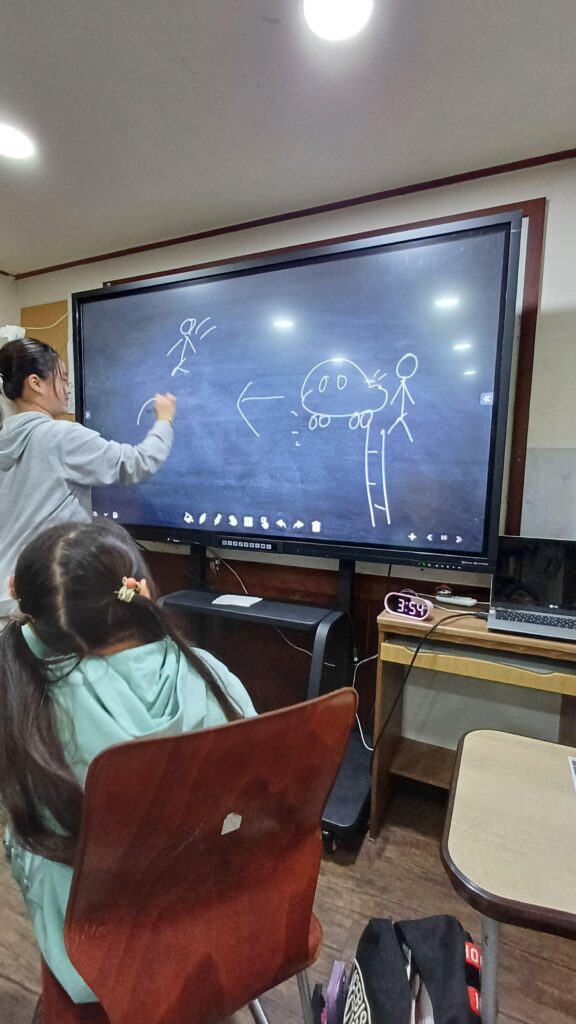
I love drawing and am happy to use the board to sketch pictures for the whole lesson. Of course, it’s better to involve the students as much as possible, so after a few examples, I reluctantly hand over my marker pens and let this become a student-centered exercise.
-The teacher prepares for the exercise by writing down about 20-30 recently learned adjectives on cards.
-To begin the exercise, one student stands at the board, and the teacher shows them a card.
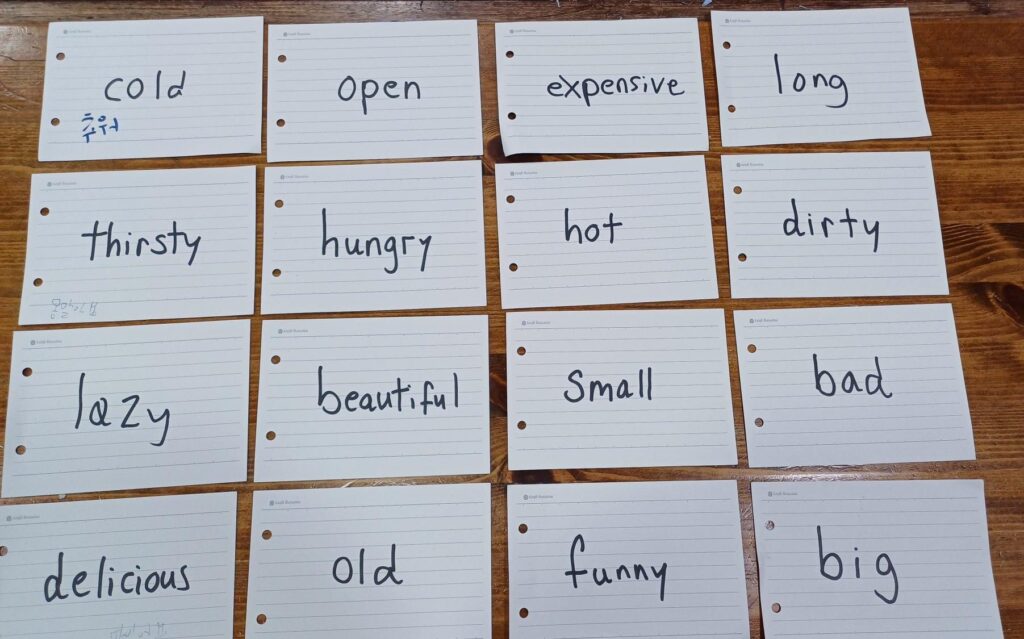
-The teacher checks that the student understands the adjective written on the card.
The student then describes the adjective by sketching a picture that reflects it, which the other students must guess.
-The first student to guess the adjective correctly from the sketch gets to stand at the board, and so on.

Students enjoy this exercise, especially when the student at the board is hopeless at sketching!
(If you were wondering, she was trying to sketch ‘dangerous’, and she couldn’t believe someone had gotten it correctly!)
4. Adjective Telepathy
This exercise aims to help students think of a suitable adjective to modify a noun. If the adjective they choose is the same as the teacher’s choice, they have good ‘telepathy’ (and gain a point).
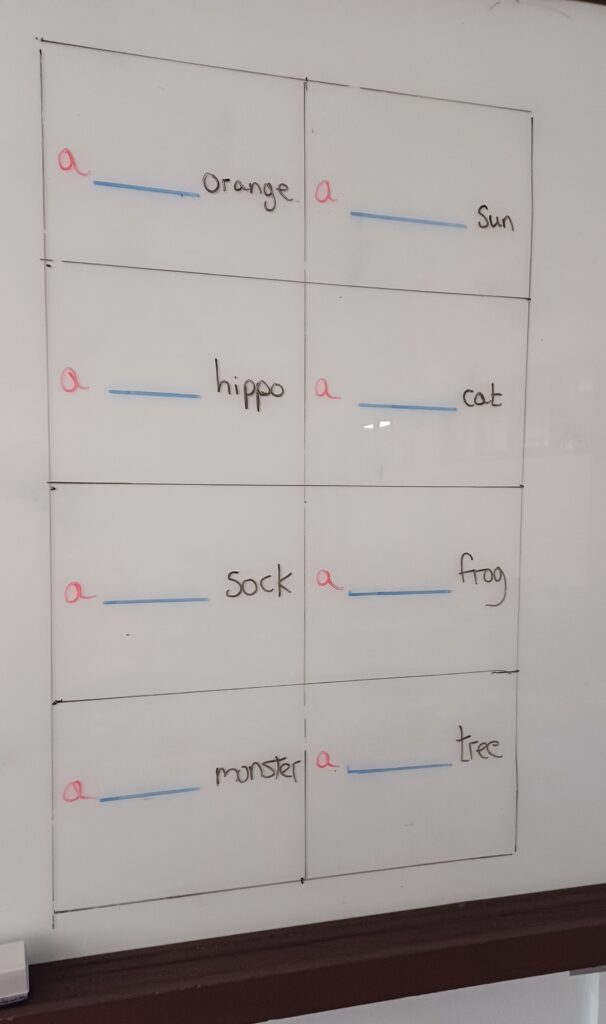
-To begin, the teacher draws an 8-box grid on the board.
-In the first box, the teacher writes the article (a/an) and a blank space, followed by a noun.
-The students do the same in their notebooks.
-The students must write down an adjective that they believe best describes the noun.
-If the students are struggling, the teacher can help them by giving them a hint or two.
-The exact process is repeated for each box.

Once all eight boxes have been filled in, the teacher goes through each box, discussing adjectives that complement the noun well (for example, in the first box, a fresh orange, a delicious orange, etc.).
-Then the teacher ends the suspense and calls out their selected adjective.
-Students with the same adjective as the teacher can check that box for a point.
-The student with the most points at the end of the exercise wins an expensive watch ⌚!…um, or whatever you are using for a reward.
-If two students tie the score, I sometimes have a quick playoff with one more noun….there can only be one winner!!)
4. Noun Telepathy

-This is a reverse version of the previous exercise.
-The aim here is for the students to try to have ‘telepathy’ with the teacher and choose a noun that complements the adjective.
-The teacher draws the same 8-box grid on the board, and the students do the same in their notebooks.
-This time, however, the teacher writes out an adjective and leaves a blank in the noun position.
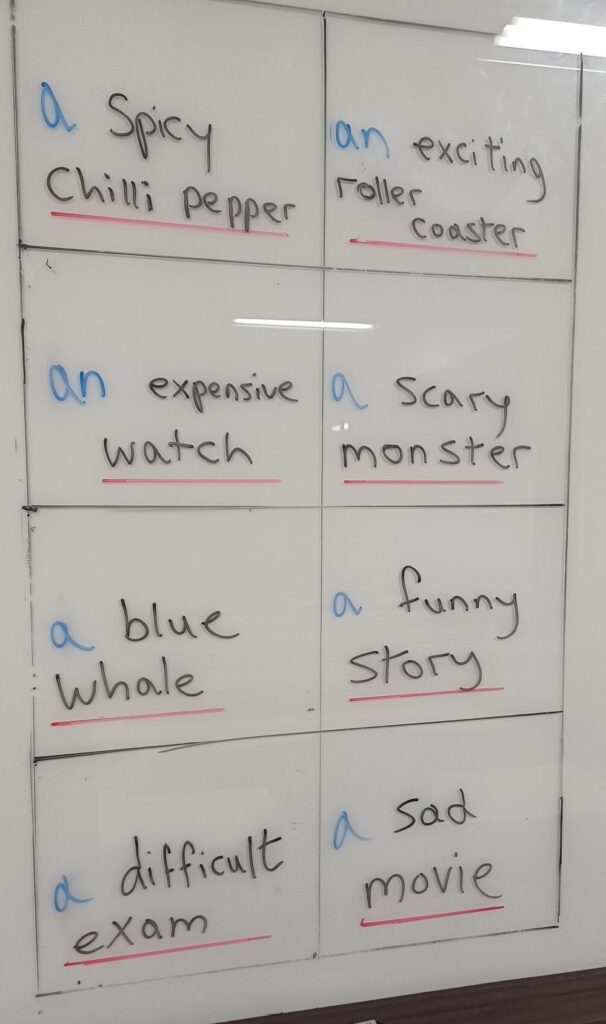
-The students must fill in the blank with a noun they think is modified by the adjective.
-There are far more nouns than adjectives (duh), so to get the students on the right track, the teacher can give hints about the target noun they are thinking of.
Like in the previous exercise, once all the boxes have been completed, the teacher works through each box and suggests a few nouns often paired with the adjective in the box. Finally, they call out the noun they have chosen.
6. Adjective Scavenger Hunt
This is probably my favorite activity for practicing adjectives. However, I’m lucky enough to teach in a school with access to a large yard, a library, and a student kitchen. I also have an understanding boss😊 . If you teach in a gray, windowless classroom, this activity probably isn’t the one for you.
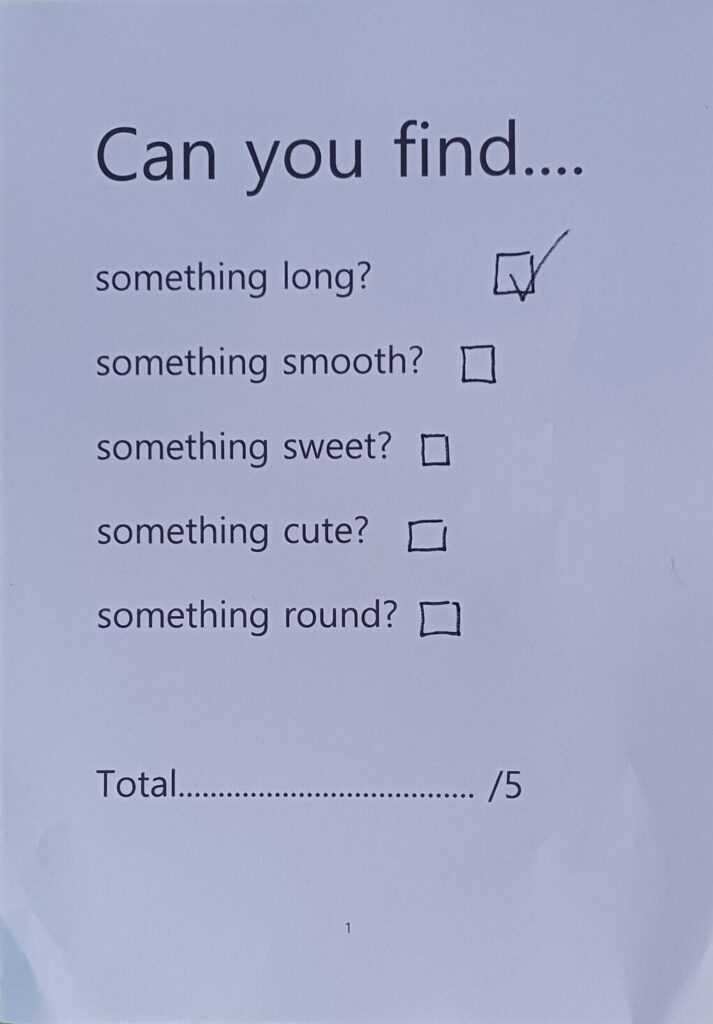
-For this exercise, the teacher writes out a list of things for the students to collect, but instead of listing the objects themselves (as you see in a usual scavenger hunt), the teacher writes out a list of instructions as in the picture.
-The teacher divides the students into teams.
-Next, the teacher gives out a list to each student. ( I usually put the lists into envelopes )
-The students are instructed to open the envelope and read the instructions.
At the teacher’s command, they race off to find suitable objects that match the adjectives on the list.
Note: Students can get quite excited during this exercise, so I like establishing a few behavioral ground rules before the action starts. I do this through ‘yes’ and ‘no’ concept-checking questions. For example:
Teacher: When things, is ok to run? No!
Teacher: Is walking quickly ok? Students: Yes!
Teacher: Is shouting and talking loudly ok? Students: No!
Teacher: Is whispering ok? Students: Yes!
Teacher: Is entering a classroom during a lesson ok? Students: No! (That’s happened before 🙄)
Teacher: Ok …..Ready ….Go!
7. ‘Name it in three!‘
No more than three adjectives usually modify nouns in English. For example:
‘A big, clear, blue sky’
So three is the magic number! This fun and challenging quiz game can be used for higher-level classes. Teams aim to ‘help’ one of their members guess a mystery object by telling them three adjectives that describe it.
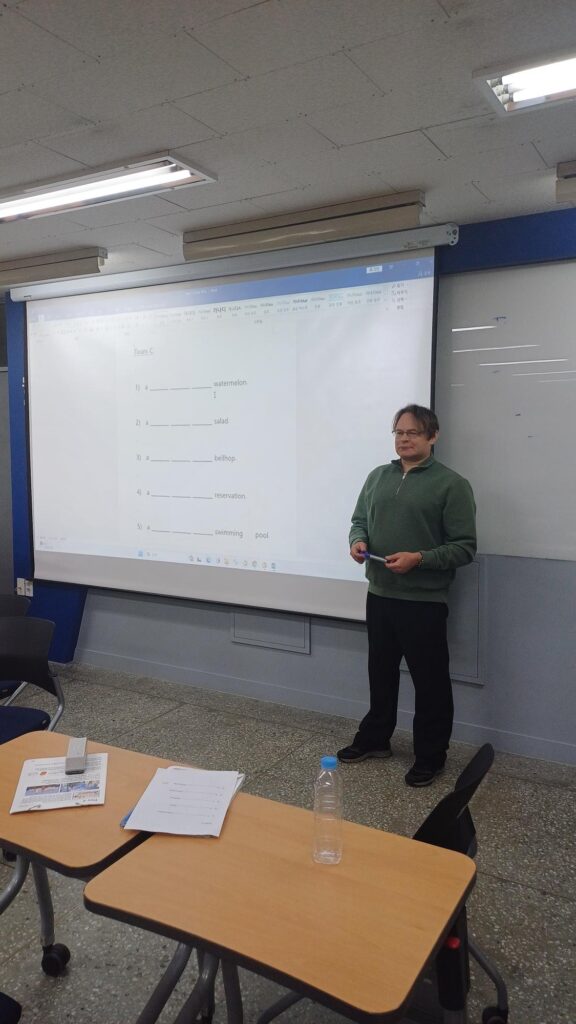
-To begin, the class is first divided into two or three teams.
-Each team nominates a team member to stand outside the classroom (no eavesdropping).
-The teacher then gives each team a sheet. Each sheet has five target nouns written on it. An article and three blanks precede the nouns.
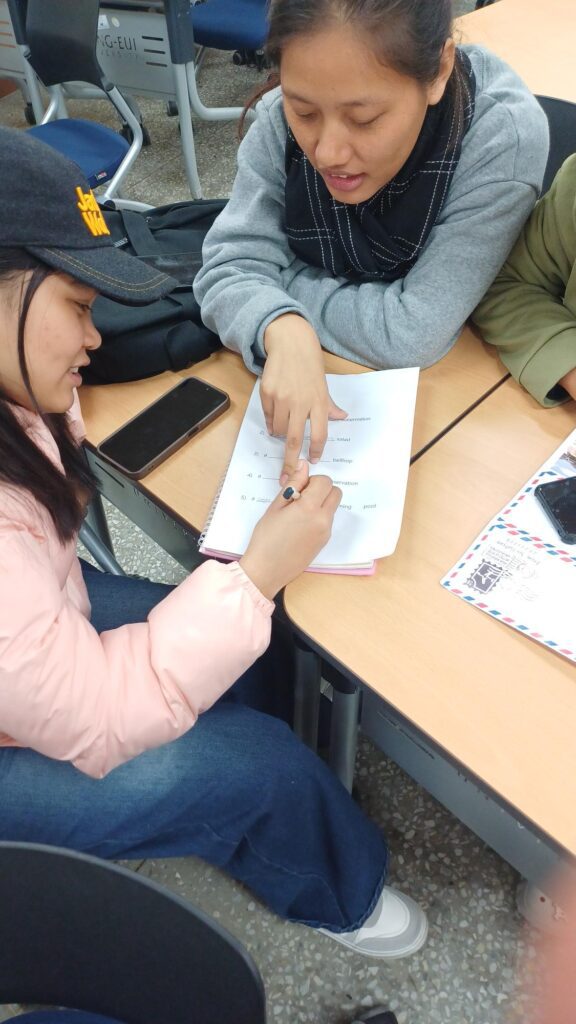
-The teams huddle together and choose three adjectives to best describe the target noun.
-During this time, the teacher monitors and guides the teams to ensure they are thinking up accurate adjectives.
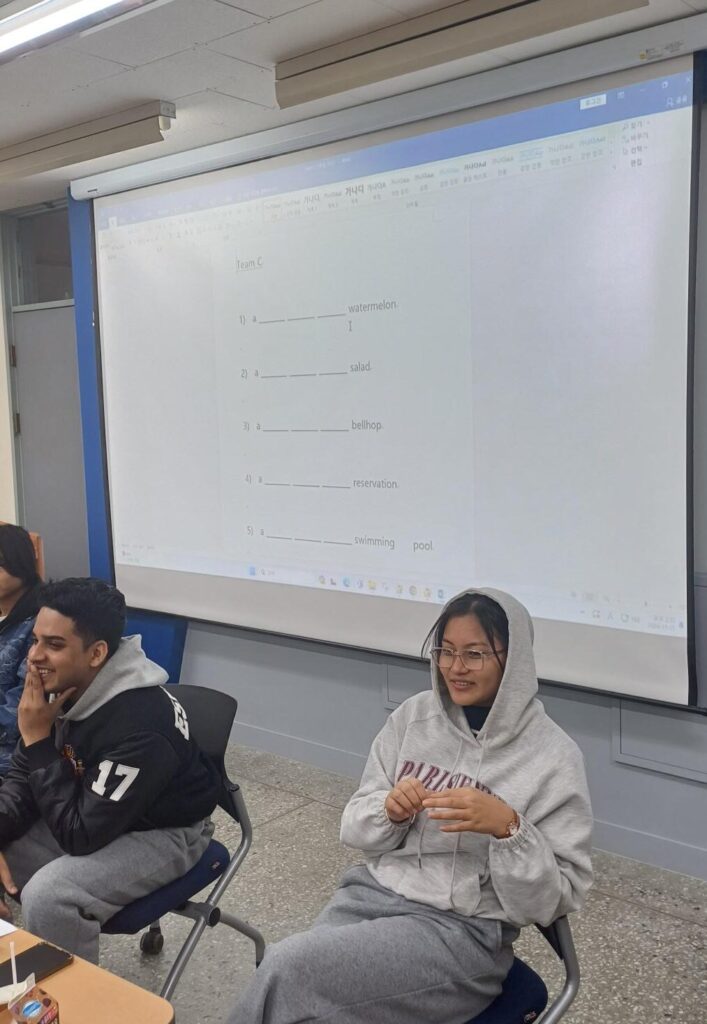
-Once all the teams are ready, the guessing students are allowed back in the classroom and sit with their backs to the board.
-For each of the five nouns, one team member calls out the three adjectives they have decided will help their team member guess correctly.
-If the student guesses correctly, their team gets a point. If they guess incorrectly, one of the students sitting from a different team is allowed to have a guess and steal a point for their team.
-After each team has described five nouns, the exercise is over, and the team with the most points wins. High fives all around!
Note: The Students sometimes ‘accidentally’ call out a helping noun or use body language. In this case, the opposing teams get a free guess.
8. Alphabet Adjectives
This is a terrific way to practice simple adjectives in the classroom. For this exercise, each student has to remember a growing shopping list of items, including an adjective that describes each item, and then add one more thing to the list.
(As a bonus, it also gives the students practice using the indefinite article (‘a/an’) and single and plural nouns.)
-To start, the teacher writes out the alphabet in the center of the board. Two blanks precede each letter. Like this:
__ __ a,__ __b,__ __c,__ __d……….
-At the top of the board, the teacher writes out :
‘Last week I went shopping and I bought …‘
-First turn: The teacher asks a student to read the sentence aloud and then points to the letter ‘a. The student thinks of an item beginning with ‘a’ and completes the sentence. Like this:
(They always choose ‘apple’!)
-Second turn: The teacher then asks the next student to repeat the sentence, but this time to include an adjective before ‘apple’ AND to add an item beginning with ‘b’. Like this:
(They always choose ‘banana’!)
-Third turn: Now the students will start to understand the process. The next student can continue by adding an adjective for the banana and an item beginning with ‘c’. Like this:
The teacher can now step back and monitor as the students take turns adding one item for each letter and an adjective to the previous item. The students will aim to complete the whole ‘alphabet shopping list’. For the final turn, I get all of the class to complete the ‘Z’ together. It’s a team effort!
This exercise is most effective for classes of 4-8 students. In this way, each student gets to have several turns.
Notes
The students often choose items that certainly wouldn’t be on my shopping list, but they find it fun to buy more ridiculous things as long as they come up with suitable adjectives for their choices; that is fine.
The exercise can take up to 45 minutes from beginning to end and may run over the class time. In this case, I screenshot the board so the students can continue from where they left off in the next class.
9. Opposite Adjectives
Many adjectives have a precise opposite, so practicing them together is an effective way to learn two at once. Once the students understand what they must do in the exercise, I hand over the running to a ‘referee student’, who becomes a student-only exercise. Then I can sit back and think about my lunch 🌮.
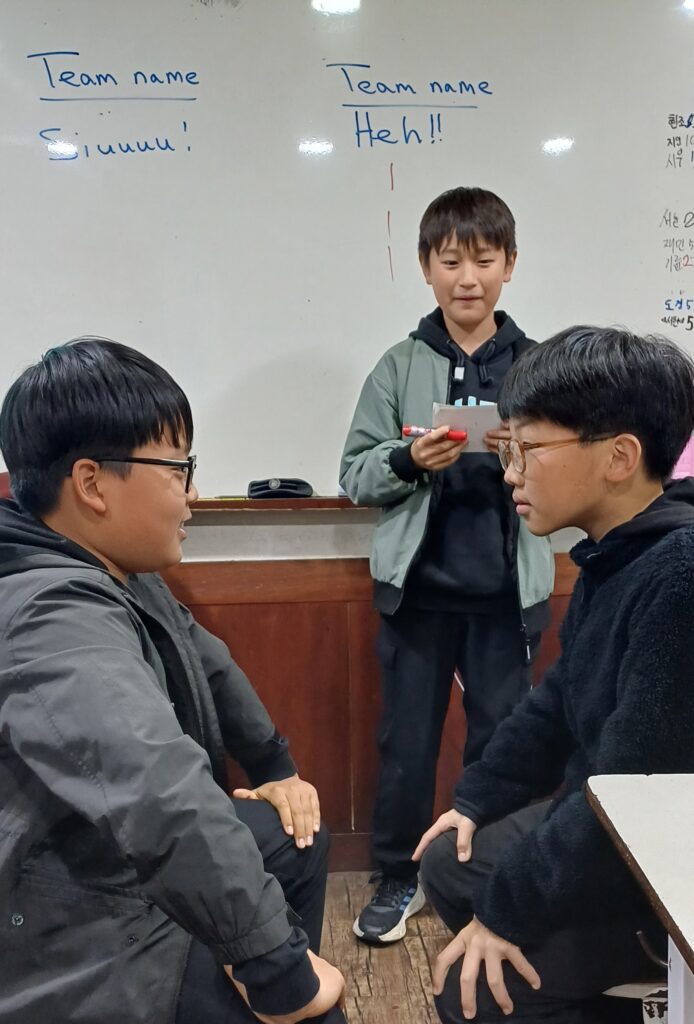
-To play this game, the teacher prepares pre-written cards showing pairs of opposite adjectives that the students have already learned.
-The teacher divides the class into two teams of roughly equal ability.
-One student from each team comes to the front of the class and sits face-to-face with the opposing student.
The teacher (or referee student) then calls out one adjective from the card, and the first student to call out the correct opposite written on the card gets a point for their team.
-Because they are face-to-face, the students try to make each other lose concentration. The teacher (or student) can increase the tension by making them wait before calling out the adjective.
After each team member has had a few tries, the exercise is over, and the teacher tallies the scores to determine the winning team.
10. Shout Out Some Nouns!
This exercise follows a similar format to the ‘Name it in three’ game. The basic format is the same, with the class divided into two or three teams of equal ability.
-To begin, a nominated guessing student from one team comes to the front and sits with their back to the board.
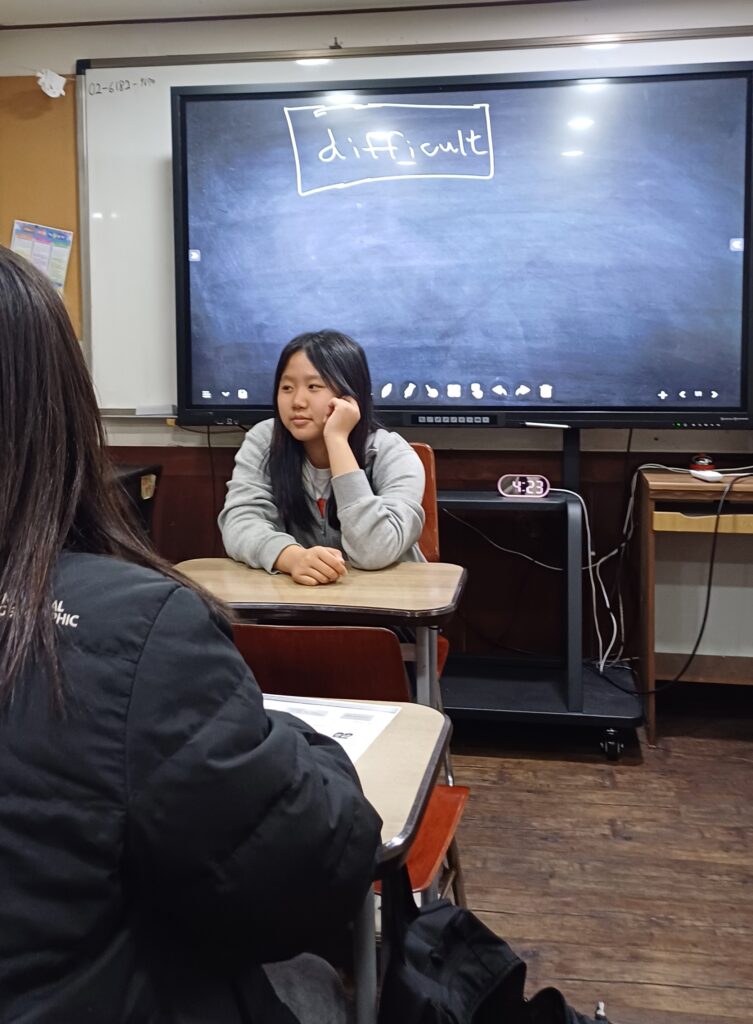
-The teacher has a list of adjectives ready.
-The teacher writes an adjective on the board. For example: difficult.
-The team then has to call out nouns they think have a good connection with the adjective.
-The guessing student listens to their team calling out these nouns and tries to guess the target adjective. If correct, the team scores a point, and the teacher writes up the following adjective.
-Each team has a set time ( about 4-5 minutes) to get as many points as possible.
…………………………………………………………………………………………………………………………………
*If you and your students had fun with these activities, check out my book,
The Emergency English Teacher is stacked full of fun stuff for all student levels. It helps fill up that dreaded time at the end of a lesson.
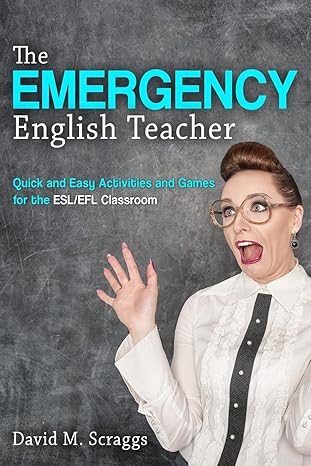
.
…………………………………………………………………………………………………………………………………………………………………………………………………………………………………………………….